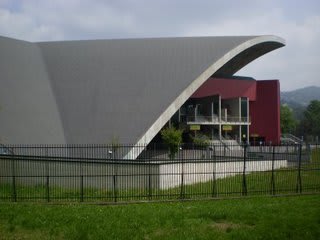I would like to speak about a monument of Torino which is not commonly featured in guides and is not about "historical" architecture. To introduce this issue, I would like to explain to you how the Italian mind, and specifically the Turineis one, think about architecture and the looks of our city. In most places in the world, and especially outside Europe, building something "new" is considered positive: the modernity of a city or of a country, expressed not only by the style of life, but also by the looks of the cities, is a matter of pride for most. In Europe, often, building something "new" is considered a "damage" to the traditional looks of the city. So, if something new is built at all, usually it is outside the downtown areas because people are opposed to building anything modern besides our historical downtowns: and even outside downtown areas, people are often opposed to the building of skyscrapers or "tall" buildings (which , I believe, are the main embodiment of modern architecture). So this means that in Europe, most often the most modern buildings are in the peripheral areas of a city. In Italy this is strongest, and few things notable were built after the 60s. In Torino it is even worse: there are projects to build skyscrapers or tall buildings, but soon, groups of protesters get organized and often, the projects are canceled. I think this has no sense: for centuries, our cities did not care about such things. It can even be argued that our cities are beautiful because they are the mix of many different and splendid architectures from different periods of a long history: take Rome for example, where you can see Roman buildings, monuments from the Middle Age, and Renaissance or Baroque palaces standing side by side. Now people want to keep everything frozen in time, and I am not sure it is a good thing.
Anyway, there are a few things built in the modern era which are striking: one rare example in Torino, and one I like a lot, is the Palavela. Palavela means "sail palace": that is because the roof of the building looks like a huge concrete "sail". It was built in 1960, projected by an engineer, Franco Levi, and the two architects Annibale Rigotti and Giorgio Rigotti. The reason it was built was to celebrate 100 years of the Unity of Italy: in fact Torino was the capital city of the country which unified Italy, and the first capital of the united Kingdom of Italy in 1860. The Palavela, in his original form, had wide glass windows leading down from the cement roof to the ground. The space inside was enormous, and it was meant to be used to host fairs, salons and manifestations during the "Italia 61" celebrations. Sadly, after the celebrations, the Palazzo Vela (this is the complete name of the building) fell in disuse and disrepair. The color became darker, and from a spectacular monument, it became a big ugliness, empty and bad looking. I believed it would have been tore down some day. But luckily, a thing happened. Torino was awarded the 2006 Winter Olympics and the Palavela was chosen to host figure skating competitions. And finally it was renovated to its present form. Of course, some people protested because the renovation did not preserve the original glass windows. And under the big concrete sail there are two new buildings, where skating and basketball competitions are held. When you watched Shizuka Arakawa in her gold medal, she did so under this big sail which is one of the most daring and courageous buildings made in Torino in the last 100 years. So, here are the pictures: I hope you enjoy.

Anyway, there are a few things built in the modern era which are striking: one rare example in Torino, and one I like a lot, is the Palavela. Palavela means "sail palace": that is because the roof of the building looks like a huge concrete "sail". It was built in 1960, projected by an engineer, Franco Levi, and the two architects Annibale Rigotti and Giorgio Rigotti. The reason it was built was to celebrate 100 years of the Unity of Italy: in fact Torino was the capital city of the country which unified Italy, and the first capital of the united Kingdom of Italy in 1860. The Palavela, in his original form, had wide glass windows leading down from the cement roof to the ground. The space inside was enormous, and it was meant to be used to host fairs, salons and manifestations during the "Italia 61" celebrations. Sadly, after the celebrations, the Palazzo Vela (this is the complete name of the building) fell in disuse and disrepair. The color became darker, and from a spectacular monument, it became a big ugliness, empty and bad looking. I believed it would have been tore down some day. But luckily, a thing happened. Torino was awarded the 2006 Winter Olympics and the Palavela was chosen to host figure skating competitions. And finally it was renovated to its present form. Of course, some people protested because the renovation did not preserve the original glass windows. And under the big concrete sail there are two new buildings, where skating and basketball competitions are held. When you watched Shizuka Arakawa in her gold medal, she did so under this big sail which is one of the most daring and courageous buildings made in Torino in the last 100 years. So, here are the pictures: I hope you enjoy.











